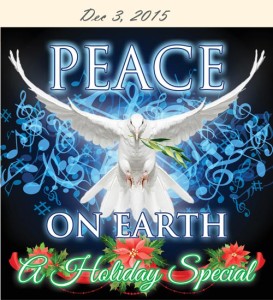[su_row]
[su_column size=”1/2″]
Concert December 3, 2015 at 7:30 PM
Wine & Cheese Reception 6:30 pm
Cailloux Theater – Kerrville, Texas
[/su_column]
[su_column size=”1/2″]
Evening’s Performances
Ode to Joy Ludwig von Beethoven
Messiah George Frederic Handel
Shephard’s Hey Percy Aldridge Grainger
Christmas Eve Sarajevo 12/24 Paul O’Neill
Hanukkah Light Bavel
White Christmas Berlin
[su_row]
[/su_column]
[su_column size=”1/2″]
To learn more about this concert, see the Conductor Letter and Program Notes below.
[/su_column]
[/su_row]
Conductor Letter
[su_row]
[su_column size=”1/2″]
Dear Symphony of the Hills Community,
The winter holidays are a favorite time of year! Many of us take the opportunity to be with family and friends and to celebrate our blessings in various ways. A common theme of the holidays is “peace.” This is a time of year when we pray and hope for peace in our families, communities and nations. We have so many comforts in our lives today that many people around the world do not have. We are fortunate to live in a free country where peace (for the most part) reigns. The music chosen for the Symphony of the Hills winter concert celebrates these blessings through some of the greatest orchestral works ever composed.
George Frideric Handel wrote his landmark oratorio Messiah in a burst of creative inspiration. He wrote all of the music for this 3-part, 3-hour long work in just 24 days! The opening words of the opening tenor solo are a peaceful message, “Comfort ye my people.” The libretto of Handel’s Messiah is the story of a promised savior for all people of the world. The music is at times peaceful, and at times dramatic. Peace comes at a cost… Of course, we will not perform all 3 hours of Messiah—just segments including the famous “Hallelujah Chorus.” We are so proud to feature our Grand Symphony Chorus at this concert under the direction of Dr. David Baker and Ms. Lynda Ables.
[/su_column]
[su_column size=”1/2″]
If you enjoy this Symphony of the Hills concert, I hope you will join concert sponsor James Avery and others throughout the season whose passionate support keeps symphonic orchestral music vibrant in our community.
Thank you for your attendance and I hope to see you at our Pops concert (A Night at the Movies – Hollywood Favorites) on January 9!
From all of us at the Symphony of the Hills, we wish you a Merry Christmas and hope your holidays are filled with peace and cheer.
Gene Dowdy
Conductor & Artistic Director
[/su_column]
[/su_row]
Program Notes[su_row]
[su_column size=”1/2″]
Ode to Joy
Ludwig von Beethoven
This familiar piece of music might be recognized as the final movement of Beethoven’s Ninth Symphony, and is often characterized as the most stunning and glorious of all of Beethoven’s works. The composition is most often performed by combining a large chorus and full orchestra in order that the total dimension of the music can be experienced. The piece has been adopted as the Anthem of Europe by the Council of Europe in 1972, and subsequently by the European Union. It is traditionally performed in celebration of the Christian holidays.
Completed by Beethoven in 1824, Ode to Joy (German: An die Freude) was inspired by, and employs the words of, the poem of the same name by Friedrich Schiller, written in 1785 and intended as a celebration of freedom. It has been used as background in numerous motion pictures and was partially incorporated in music by the Beetles.
Messiah
George Frederic Handel
In any discussion of the real masters of the Baroque period, the names most immediately springing to mind are Johann Sebastian Bach and George Frideric Handel. However, while contemporaries and prominent figures of the late-Baroque style, they employed a number of compositional elements in sharp contrast with each other.
The Messiah, a widely-performed and majestic piece of music by Handel, was written in England where Handel had lived since 1712. This magnificent composition, written in 1742, was the sixth English oratorio Handel wrote in his development of the Italian opera genre, a structure he turned to in response to changes in public taste. Although the structure of Messiah resembles that of opera, it is not in dramatic form; there are no impersonations of characters and no direct speech. Instead, the text, by Jennen, is an extended reflection on Jesus Christ as Messiah. The text begins in Part I with prophecies by Isaiah and others, and moves to the annunciation to the shepherds, the only “scene” taken from the Gospels. In Part II, Handel concentrates on the Passion and ends with the “Hallelujah” chorus. In Part III he covers the resurrection of the dead and Christ’s glorification in heaven.
Handel wrote Messiah for modest vocal and instrumental ensembles, with optional settings for many of the individual numbers. In the years after his death, the work was adapted for performance on a much larger scale, with giant orchestras and choirs.
Shephard’s Hey
Percy Aldridge Grainger
Percy Aldridge Grainger was an Australian-born composer, arranger and pianist. In the course of a long and innovative career he played a prominent role in the revival of interest in British folk music in the early years of the 20th century. He also made many adaptations of other composers’ works. Grainger was born in Australia and emigrated at age 13 to Germany for musical training at the Hoch Conservatory in Frankfurt. Between 1901 and 1914 he was based in London, where he established himself first as a society pianist and later as a concert performer, composer and collector of original folk melodies. As his reputation grew he met many of the significant figures in European music, forming important friendships with Frederick Delius and Edvard Grieg. He became a champion of Nordic music and culture, his enthusiasm for which he often expressed in private letters.
Shephard’s Hey is a sprightly and very familiar traditional British folk song with a simple melodic statement. The piece is often found in the repertoire of experienced folk musicians. The arrangement builds in intensity and tempo through the final musical punctuation. Subtle intricacies are clearly demonstrated with the addition of characteristic counter melodic material.
[/su_column]
[su_column size=”1/2″]
Christmas Eve Sarajevo 12/24
Paul O’Neill
“Christmas Eve/Sarajevo 12/24” is an instrumental first released on the Savatage album Dead Winter Dead in 1995 and re-released by the Trans-Siberian Orchestra the following year. The piece was inspired by a lone cello player playing a forgotten Christmas carol in war-torn Sarajevo during the period of the Bosnian War 1992-95, written by the New York born composer and lyricist Paul O’Neill. O’Neill has been affiliated with Savatage and The Trans-Siberian Orchestra, both rock bands of the late ‘90’s.
Hanukkah Light
Zamir Bavel
Hanukkah Light is an orchestral setting of historic Jewish holiday music in celebration of Hanukkah. In this work Bavel takes popular Jewish folk melodies and presents them in a popular symphonic sound.
White Christmas
Irving Berlin
In 1942, during a very difficult time for the U. S., Paramount Pictures released a film musical based on Irving Berlin’s idea for a screenplay. His concept was centered around an inn that opened only on public holidays. The film production was begun in 1940 by Paramount with Berlin having signed an exclusive contract to write the music for the film.
The film was an enormous success in the U.S. and the U.K., the highest grossing film musical to that time. It was expected that “Be Careful, It’s My Heart” would be the most popular song from the movie. Although that song did well, it was “White Christmas” that topped the charts in October 1942 and stayed there for eleven weeks. This song has remained a favorite of Americans for 70+ years, being played again and again during the Christmas holidays here and internationally, during which time we are often reminded that the tune was written by a Jewish composer.
Concert Notes by Jim Adams
[/su_column]
[/su_row]



